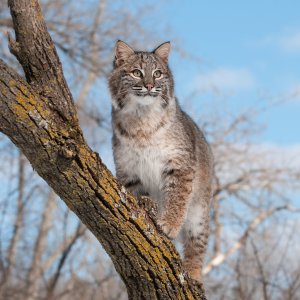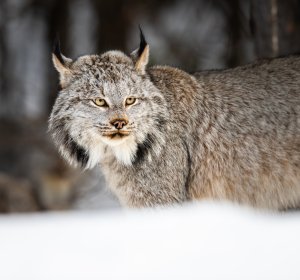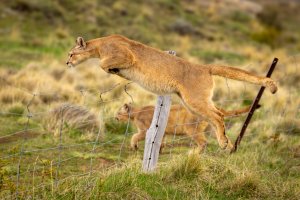From the Past to Meow: Michigan’s Wild Kitties
August 7, 2024
By: Ali Groulx, Park Interpreter
Cats are unlike any other house pet.
They themselves decided to join society, seeing humans as an untapped resource just waiting to give them scraps of meat and chin scratches. Though we do our best to keep them happy, some escape our homes and take to the streets, fulfilling songbird’s nightmares at a pace unmatched by any other predator. The prowess of felines propels them to the top of the carnivore food chain. Their tools are nearly perfect; needle-sharp claws safely sheathed in their paws, sharp teeth, laser-like precision, and a voracious appetite for flesh. Tracks, markings, and scat must be used to determine the presence of a wildcat. They are so stealthy and nonchalant, lounging in trees silently watching the world around them. Avoidant of humans at all costs, our Michigan wildcats should not strike fear in your heart but perhaps a warm, fuzzy feeling of awe. Join us as we explore which wild kitties call Michigan their home, and the ways they have adapted to our near constant change in land use and notoriously indecisive climate.
Tree Climbers with an Agenda

Cats tend to inform their home location based on the menu, choosing areas abundant with healthy options like rabbit, rodent, and in the bobcat’s case, small deer. If I asked you to imagine a 20-pound cat climbing up a tree, you may predict that the next in the chain of events would be to call the fire department. For a bobcat, though, climbing trees gives them the perfect covered spot to stalk, using the element of surprise and their spotted, camouflaged coat to their advantage. Seemingly dropping out of nowhere, a herd of foraging deer can quickly lose one of their numbers to the powerful hunting skills of the bobcat. The bobcat pounces down and wraps her outstretched paws around the deer, claws extended, attaching like an unholy horse saddle. If conditions are perfect, a precise bite will be delivered to separate the spine, rendering their prey immovable and (usually) dead. Bobcats know to work smarter, not harder; a deer will feed them for longer than a mouse or an opossum will. Weirdly enough, if they cannot find success on land, bobcats are low-key like Michael Phelps in the water. Their swimming abilities allow for new gastronomic delights like beaver, highlighting their willingness to have a varied diet and explaining their existence in just about every corner of Michigan. Now, ponder this… their scientific name is Lynx rufus, which makes me think that “Rufus” would be a better name, but alas, the name of “Bob” refers to their teeny striped tail instead of an ancestor named “Robert.”
Murder Mittens and Fluffy Kittens

There exists a slightly larger and fluffier cousin of the bobcat who prefers bounding along in the snow – lynx canadensis. This cousin, known as the Canada lynx, is a notoriously picky eater and much less adaptable than the wide-ranging bobcat. Boasting paws as big as the palm of your hand and a mutton-chop that would make Ambrose Burnside roll in his grave, the Canada lynx inhabits the boreal forests of our northern Great Lakes region. Their thick silvery coat lacks the bobcat’s spots and their tail is short and tipped with black, like they have dipped it in paint. Their ears are topped with long tufts that they can use like eyebrows to communicate and camouflage. Though hunting behavior stays the same between cats, the lynx goes as far as becoming reliant on a very specific animal – the snowshoe hare. The size differences between a cotton-tail rabbit and a snowshoe hare are ironically like the differences between a bobcat and a lynx – a slightly huskier build, longer legs with unreasonably large paws, and a fluffier coat, perfect for the harsher climates they prefer to roam. Because of the limited resources available, both the hare and the lynx depend on their relationship to keep their populations healthy, least they cause a destructive spiral of chaos. Though they never talk, there is an unspoken agreement between the two; a lifelong adage that reciprocity is the key to a sustainable community.
The Cat with Many Names

Cougar, mountain lion, puma, panther, and catamount all describe the same cat – puma concolor, a large, solid colored cat with a long tail. Their range in our hemisphere is the largest of any land mammal in North and South America, hence all the names. From rocky outcrops to dense forest, from unrelenting heat to temperatures chill to the bone, these large mammals are the biggest cat of the feline family – which is a different from the “big cat” branch called Pantera that lions and tigers belong to. They are the fourth largest cat in the world weighing in at a max of 220lbs, despite not being scientifically classified as a “big cat.” Their powerful legs give them the strength to leap 18 feet up into the air from a crouch, so not even trees are safe for their prey. Like other cats, cougars hunt using stealth and great bursts of energy, delivering a life-ending bite as close to initial confrontation as possible, and save for a mother with cubs, they are generally loners. The tempting buffets of valuable livestock kept by farmers led to the cougar’s decline in many parts of the country, including Michigan where there are very few. Their presence is mostly in the upper peninsula, where they are captured on trail cameras, rarely making an appearance to the naked human eye. If you’re interested, you can check out this cool cougar sighting datasheet through the DNR. It includes location, pictures, and other information that can help us appreciate this rare Michigan wildcat. Odds are that you won’t come across a cougar in the wild, but if you do, here are 10 things you can do to stay safe while in their habitat.
Wildcats find their homes in Michigan, living adjacent to humans and attempting to avoid detection at all costs. Sometimes they even look like our cats, endearing themselves to us though the feeling is not mutual. Wildcats are wild, and as I tell my partner quite often, “we can NOT have a lynx as a pet!” If you have or know someone with a house cat, take a moment to watch them play – and imagine those skills times ten out in the wild! It is so cool to know our pet’s wild ancestors and is a good reminder that no matter how small, our kitties still have the hearts and the brains of one of Earth’s smartest and formidable predators. And dog lovers – do not worry – we will explore canine ancestors here soon!
